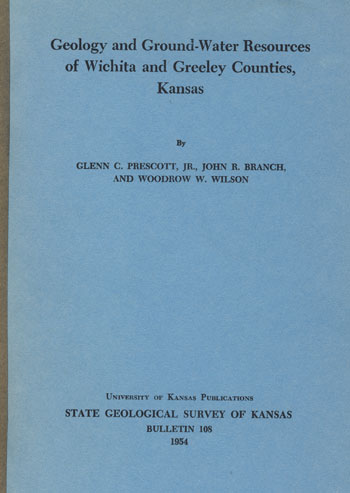Geology and Ground-water Resources of Wichita and Greeley Counties, Kansas
By Glenn C. Prescott, Jr., John R. Branch, and Woodrow W. Wilson

Originally published in 1954 as Kansas Geological Survey Bulletin 108. This is, in general, the original text as published. The information has not been updated.
You may also wish to visit our web sites on the Wichita and Greeley county geologic maps.
Abstract
This report describes the geography, geology, and ground-water resources of Wichita and Greeley counties in western Kansas. The area consists of a flat to gently rolling plain, which slopes eastward [at] about 15 feet per mile. A short reach of Ladder Creek (Beaver) is the only perennially flowing stream in the two counties. Ephemeral streams, which flow only during and after heavy rains, are White Woman and Sand Creeks and the western reach of Ladder Creek. The climate is semiarid, the normal annual precipitation being about 17 inches in Wichita County and 16 inches in Greeley County. Agriculture is the principal occupation in the area, and wheat is the most important crop. A considerable area is irrigated; sugar beets and sorghums are the principal irrigated crops.
The outcropping rocks range in age from late Cretaceous to Recent; the Smoky Hill chalk member of the Niobrara formation, which is exposed along White Woman Creek in western Greeley County, is the oldest. The Niobrara is almost everywhere overlain by the Ogallala formation of Pliocene age. Generally the Ogallala is overlain by windblown silt of the Pleistocene Sanborn formation, but in places it is exposed along streams. The most recent deposits are dune sand and the alluvium along the streams. The Dakota formation, which is an important aquifer in parts of Kansas, is 300 to 450 feet beneath the Niobrara formation.
The ground water that is available to wells in Wichita and Greeley counties is derived entirely from precipitation in the area or in areas immediately west and north. Ground water moves in a generally easterly direction with a gradient that varies inversely with the permeability of the water-bearing beds. The ground-water reservoir is recharged principally by precipitation within the area or within adjacent areas, Ground-water discharge takes place principally by pumping from wells, subsurface outflow, and evaporation and transpiration. Most of the domestic, stock, public, and irrigation supplies are obtained from wells. It is estimated that probably more than 2 billion gallons of water is pumped annually from wells in the area. Since 1947, ground-water recharge has been about equal to ground-water discharge.
The use of ground water for irrigation has increased greatly since 1946 and indications are that many more wells may be drilled and pumped without dangerously lowering the water table. Approximately 11,000 to 12,000 acres were irrigated in 1951. A map showing the thickness of water-bearing materials indicates that although much of the area has enough water-bearing material to support irrigation wells, parts of Wichita and Greeley counties have little or none.
The Ogallala is the principal water-bearing formation in the area. Small amounts of water may also be obtained locally from alluvial deposits and from cracks in the Niobrara formation. Two deep test wells to the Dakota formation have been drilled but, because of the poor quality of the water, have never been used.
The ground water in Wichita and Greeley counties, though hard, is suitable for most purposes. Water from the Ogallala is generally high in fluoride and in some cases may be injurious to the teeth of children. Water from the Dakota, though soft, is unfit for irrigation because of a high content of sodium.
The field data upon which most of this report is based are given in tables; they include records of 417 wells, chemical analyses of 31 samples of water, and logs of 57 test holes and wells.
Kansas Geological Survey, Geology
Placed on web Jan. 11, 2008; originally published April, 1954.
Comments to webadmin@kgs.ku.edu
The URL for this page is http://www.kgs.ku.edu/General/Geology/Wichita/index.html